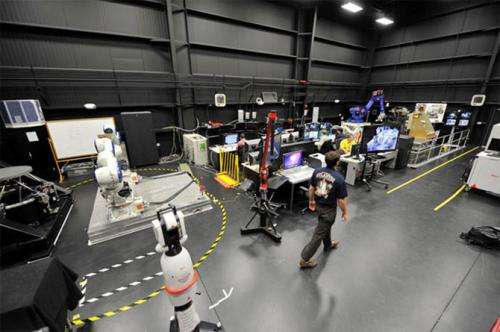NASA workshop discusses how On-Orbit Robotic Satellite-Servicing becomes reality

(Phys.org) -- Envision a space with more options and increased capacity: a place where aging and ailing satellites could place a service call for a helpful boost to the right orbit, a quick repair, or a fuel top-off to keep them operating longer. According to many of the speakers and attendees at NASA’s Second International Workshop on On-Orbit Satellite Servicing, such long-discussed lifeline services are more than a dream of the future; they are options that could be achievable within the next five years.
On May 30-31, more than 240 international representatives gathered at NASA’s Goddard Space Flight Center in Greenbelt, Md., to discuss international near-term satellite servicing plans and delve into the issues that could either stimulate or strangle the emerging commercial servicing industry. During the event, NASA and the Canadian Space Agency (CSA) presented results to date from NASA’s Robotic Refueling Mission on the International Space Station.
“We were very excited to see such a diverse gathering of satellite manufacturers, fleet owners and operators, government representatives, and policy experts engaged in tackling the challenges to getting on-orbit satellite servicing off the ground,” said Frank Cepollina, Associate Director of the Satellite Servicing Capabilities Office (SSCO) at Goddard.
“The message from these discussions was very clear,” he continued. “Satellite fleet owners and operators want servicing capabilities. The technology to do these sorts of tasks is ready now. We believe it’s the right time to make routine and reliable satellite servicing in orbit a reality.”
After welcoming remarks by Goddard Center Director Christopher Scolese, plenary speakers Kay Sears of Intelsat General, Dr. Robert Ambrose of NASA, and Prof. Henry Hertzfeld of George Washington University kicked off the event. They verbally painted a vision of a satellite-servicing-enabled world, describing the technology needed to get there, and explaining the various legal, financial, insurance and policy challenges to be navigated.
More than thirty-five speakers and session leaders gave presentations, led panel discussions, and took audience questions during the event. Queries ranged from “How much would satellite owners profit from life-extension versus repair services,” to, “What sort of low-cost features could be implemented on satellites now to make servicing easier in the future?” Speakers included representatives of governments and private industries, satellite bus manufacturers, and fleet owners and operators, as well as representatives of insurance, finance, law, and policy. Presentations from the event are available at the SSCO Workshop website.
Attendees often referred to the “Five R’s of On-Orbit Servicing,” or the ability to remotely survey, relocate, refuel, repair, and replace individual parts of satellites in space. Participants also discussed the sixth “R” related to satellite servicing: the perceived “risk” the first mission would, by its very nature, carry and ultimately alleviate. Attendees agreed that this is a challenge best suited for NASA to resolve.
“While there has been strong interest in these sort of capabilities for decades, robotic satellite servicing in geosynchronous Earth orbit — the space highway for weather and communication satellites— has never before been attempted,” said Benjamin Reed, Workshop Chairman and the deputy project manager of SSCO. “Consistent with the United States Space Policy, NASA is actively investigating ways to remove the perceived risk and jumpstart a commercial industry to provide cost-efficient servicing solutions to satellite manufacturers, owners, and ultimately consumers.”
“We’re encouraged by the success of the recent SpaceX Dragon launch,” he continued, “and are exploring how an initial shared government/commercial servicing mission could initiate a fully commercial satellite servicing capability for America.”
The workshop followed a Request for Information released by NASA in 2011 to seek suggestions on methods for the agency to energize, stimulate, and enable the development of a domestic and commercial capability in robotic satellite servicing.
Attendees had the opportunity to visit the Goddard Robotic Satellite Servicing Center during the event, a high-tech, black-walled technology incubator located in the heart of the Goddard campus.
Since the workshop, NASA and the Canadian Space Agency have successfully concluded another set of Robotic Refueling Mission activities on the International Space Station. The two agencies are poised to begin the refueling demonstration later this summer.
The Satellite Servicing Capabilities Office (SSCO), established in 2009, continues NASA's 30-year legacy of satellite servicing and repair. Like a reliable toolkit, satellite-servicing capabilities help build, repair, and maintain critical space assets. They can be used to extend the lifespan of existent satellites, support the assembly of large structures on orbit, and mitigate orbital debris. These advances can make spaceflight more efficient, sustainable, and cost effective.
Provided by NASA





















